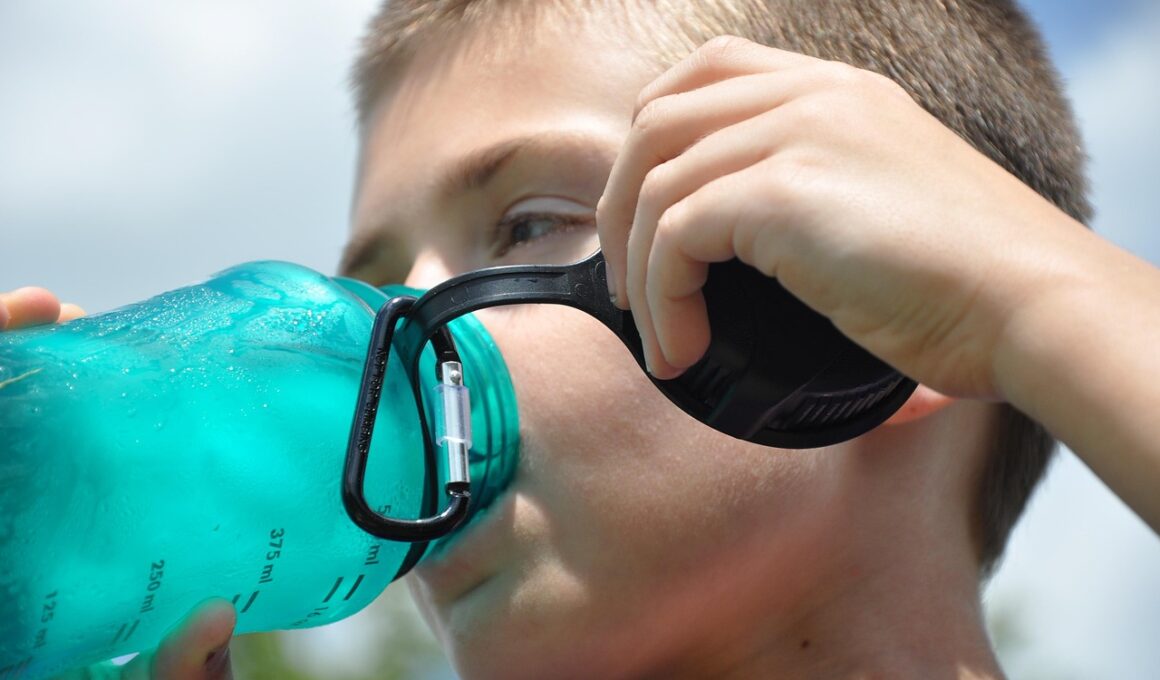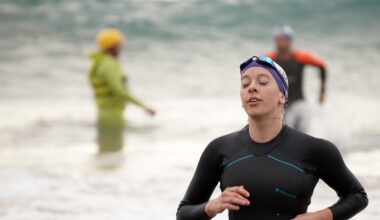Hydration and Its Effect on Outdoor Endurance Sports
Hydration plays a fundamental role in optimizing performance during outdoor endurance activities. Proper hydration supports physiological functions essential for athletes’ health and stamina, especially when athletes are engaged in long-duration events. Water regulates body temperature, lubricates joints, and aids in nutrient transport. When engaging in activities like trail running, cycling, or hiking, individuals must understand their hydration needs. Dehydration can lead to a decline in physical performance, increased perceived effort, and heightened risk of heat-related illnesses. It is crucial to establish a personalized hydration plan based on factors like climate, workout intensity, and individual sweat rates. For outdoor enthusiasts, anticipating fluid replacements during prolonged exertion is vital. Begin by evaluating personal hydration status before exercising. Utilizing hydration status indicators, such as urine color and frequency of urination, can help gauge fluid needs. Additionally, layering clothing to assist heat dissipation can enhance overall comfort and performance. Consider portable, hydration-friendly gear that facilitates easy access to fluids on the go. Maintaining hydration levels can improve endurance and speed, allowing athletes to enjoy their activities for longer durations effectively.
Understanding the signs of dehydration and knowing how to address them is important for outdoor activities. Common symptoms of dehydration include increased thirst, dry mouth, dizziness, and fatigue. During extended outdoor events, athletes should regularly check in with their hydration levels and make necessary adjustments. To mitigate dehydration risks, it is advisable to consume fluids containing electrolytes, especially during intense endurance activities. Electrolytes help maintain fluid balance in the body, thus enhancing hydration effectiveness. It is also important to practice drinking small amounts of water regularly, rather than waiting until feeling thirsty. During physical exertion in hot weather, plan hydration breaks and drink before you feel thirsty. Additionally, including hydrating foods such as fruits and vegetables in your diet could also help contribute to overall hydration levels. Watermelon, cucumber, and oranges are excellent choices for boosting fluid intake. Each athlete’s hydration strategies can vary, which underscores the need for personal experimentation to ascertain the ideal balance. Being proactive about hydration can greatly enhance overall endurance, performance, and enjoyment of outdoor sports.
Hydration Strategies for Outdoor Events
To create an effective hydration strategy for outdoor endurance sports, consider several factors that influence fluid needs during events. First, assess your body weight change before and after exercising to estimate fluid loss. This loss indicates how much water your body requires to restore balance. Keeping track of sweat rates can also be beneficial for calculating appropriate fluid intake. Another strategy is to set specific hydration goals, such as drinking a specified amount of fluid every 15-20 minutes during training and events. It can promote consistency and prevent excessive dehydration. Moreover, consider using strategies like pre-hydration, where you drink extra fluids in the days leading up to an event. Doing this can better prepare your body for exertion. Also, the temperature and humidity level will directly affect fluid requirements, so adjust accordingly. If you notice that you are sweating more than usual in hot, humid conditions, increase fluid intake. Overall, staying informed and adaptable is key to finding the right hydration strategy to suit each athlete’s unique needs.
Furthermore, it is essential to recognize the significance of recovery hydration post-activity. After completing outdoor endurance sports, recovery hydration helps restore lost fluids and aids muscle recovery. Consuming fluids containing electrolytes after prolonged efforts can expedite the recovery process. The recovery phase is crucial as it allows athletes to replenish lost nutrients and rehydrate effectively. Aim to drink at least 16-20 ounces of water or an electrolyte beverage for every pound of body weight lost during exercise within the first few hours post-activity. Additionally, coupling hydration with proper nutrition can maximize recovery potential. For instance, tasty snacks such as smoothies or fruit-infused water provide hydration along with carbohydrate and protein fueling. Moreover, athletes should adopt a mindset of hydration as a year-round pursuit, not just during events or training sessions. Forming consistent hydration habits can lead to improvements in overall health, performance, and well-being. Ultimately, understanding hydration and its importance enhances not only endurance performance but promotes long-term athletic success and enjoyment in outdoor activities.
The Role of Climate in Hydration Needs
The external environment, especially climate education on hydration, can play a significant factor in endurance sports. In high-temperature situations, athletes might experience increased sweating rates leading to greater fluid loss. Conducting outdoor activities in humid environments amplifies perspiration and can introduce challenges in regulating body temperature as well. Consequently, hydration strategies in these settings may require frequent fluid intake to prevent dehydration. Conversely, low-temperature environments may mask dehydration signs, creating a false sense of security due to lesser perceived sweat. It is essential to recognize the need for hydration in colder environments since fluid loss continues irrespective of the ambient temperature. Preparing for outdoor endurance sports should include strategies to combat the weather’s effects on hydration. For example, if it is hot, consider carrying hydration packs or bottles. In cold weather, planning to incorporate hydration-appropriate food items can alleviate the chances of dehydration. Climate can influence fluid intake requirements; adapting hydration plans based on weather forecasts is essential for optimal performance and comfort.
The choice of beverage for hydration also matters as it can impact performance during outdoor endurance activities. Water is typically the best choice for hydration, but sports drinks can provide additional benefits when exercising for extended periods. Sports drinks, rich in carbohydrates and electrolytes, replace lost nutrients and can enhance endurance. They are particularly advantageous during activities lasting longer than 90 minutes, as they help to maintain energy levels. Moreover, examine the nutritional composition of various hydration options to maximize benefits. Reduction of added sugars while enhancing electrolyte concentrations can improve absorption and endurance performance. Caffeinated beverages can also play a role in hydration; however, moderation is key. Caffeine may deliver certain ergogenic benefits during sports but should not replace primary hydration sources. Tailor your beverage choices as needed, taking into account individual preferences, exercise intensity, and duration. Maintaining a well-rounded hydration approach supports athletes in achieving their performance goals while enjoying their outdoor activities. Understanding the diverse options available empowers athletes to make informed choices that align with their hydration needs.
Conclusion: Hydration and Endurance Performance
In conclusion, the substantial impact of hydration on outdoor endurance sports cannot be overstated. Hydration affects athletic performance, health, and recovery, significantly influencing success during outdoor activities. By understanding personal hydration needs, athletes can optimize fluid intake with effective strategies tailored to individual requirements, climate, and activity type. Regular fluid replenishment throughout training and events contributes to overall performance. Additionally, creating sustainable hydration habits ensures athletes remain consistently hydrated, irrespective of strenuous activities or environmental conditions. Monitoring hydration levels and recognizing cues of dehydration enhances proactive management for improved performance. Athletes should explore beverage choices to maintain a balance of energy and fluid replacement. In the long term, adopting hydration practices will not only help improve endurance and comfort during outdoor activities but also promote overall well-being and longevity in sports. By embracing hydration as a primary aspect of training, outdoor enthusiasts can reach new heights in performance while enjoying their favorite activities. Therefore, commit to hydration, and enjoy boundless outdoor adventures with confidence!


